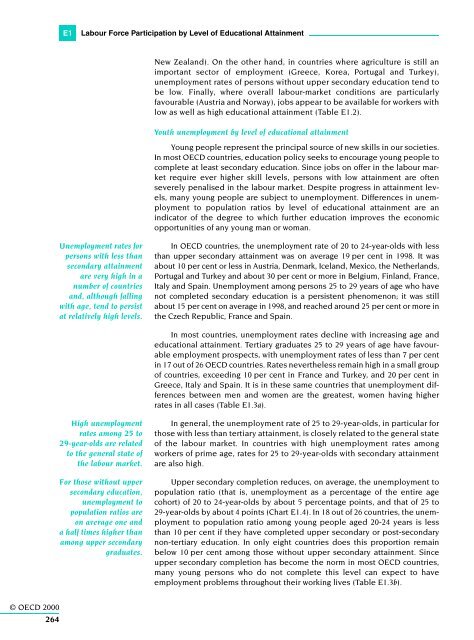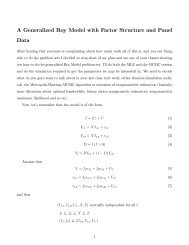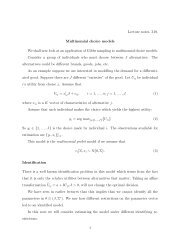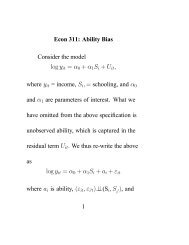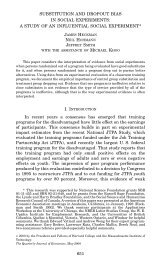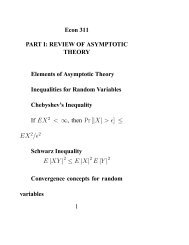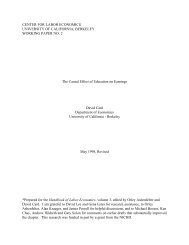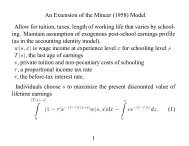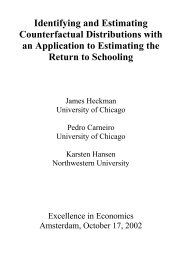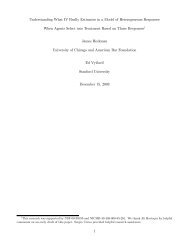OECD (2000)
OECD (2000)
OECD (2000)
You also want an ePaper? Increase the reach of your titles
YUMPU automatically turns print PDFs into web optimized ePapers that Google loves.
E1<br />
Labour Force Participation by Level of Educational Attainment<br />
New Zealand). On the other hand, in countries where agriculture is still an<br />
important sector of employment (Greece, Korea, Portugal and Turkey),<br />
unemployment rates of persons without upper secondary education tend to<br />
be low. Finally, where overall labour-market conditions are particularly<br />
favourable (Austria and Norway), jobs appear to be available for workers with<br />
low as well as high educational attainment (Table E1.2).<br />
Youth unemployment by level of educational attainment<br />
Young people represent the principal source of new skills in our societies.<br />
In most <strong>OECD</strong> countries, education policy seeks to encourage young people to<br />
complete at least secondary education. Since jobs on offer in the labour market<br />
require ever higher skill levels, persons with low attainment are often<br />
severely penalised in the labour market. Despite progress in attainment levels,<br />
many young people are subject to unemployment. Differences in unemployment<br />
to population ratios by level of educational attainment are an<br />
indicator of the degree to which further education improves the economic<br />
opportunities of any young man or woman.<br />
Unemployment rates for<br />
persons with less than<br />
secondary attainment<br />
are very high in a<br />
number of countries<br />
and, although falling<br />
with age, tend to persist<br />
at relatively high levels.<br />
In <strong>OECD</strong> countries, the unemployment rate of 20 to 24-year-olds with less<br />
than upper secondary attainment was on average 19 per cent in 1998. It was<br />
about 10 per cent or less in Austria, Denmark, Iceland, Mexico, the Netherlands,<br />
Portugal and Turkey and about 30 per cent or more in Belgium, Finland, France,<br />
Italy and Spain. Unemployment among persons 25 to 29 years of age who have<br />
not completed secondary education is a persistent phenomenon; it was still<br />
about 15 per cent on average in 1998, and reached around 25 per cent or more in<br />
the Czech Republic, France and Spain.<br />
In most countries, unemployment rates decline with increasing age and<br />
educational attainment. Tertiary graduates 25 to 29 years of age have favourable<br />
employment prospects, with unemployment rates of less than 7 per cent<br />
in 17 out of 26 <strong>OECD</strong> countries. Rates nevertheless remain high in a small group<br />
of countries, exceeding 10 per cent in France and Turkey, and 20 per cent in<br />
Greece, Italy and Spain. It is in these same countries that unemployment differences<br />
between men and women are the greatest, women having higher<br />
rates in all cases (Table E1.3a).<br />
High unemployment<br />
rates among 25 to<br />
29-year-olds are related<br />
to the general state of<br />
the labour market.<br />
For those without upper<br />
secondary education,<br />
unemployment to<br />
population ratios are<br />
on average one and<br />
a half times higher than<br />
among upper secondary<br />
graduates.<br />
In general, the unemployment rate of 25 to 29-year-olds, in particular for<br />
those with less than tertiary attainment, is closely related to the general state<br />
of the labour market. In countries with high unemployment rates among<br />
workers of prime age, rates for 25 to 29-year-olds with secondary attainment<br />
are also high.<br />
Upper secondary completion reduces, on average, the unemployment to<br />
population ratio (that is, unemployment as a percentage of the entire age<br />
cohort) of 20 to 24-year-olds by about 5 percentage points, and that of 25 to<br />
29-year-olds by about 4 points (Chart E1.4). In 18 out of 26 countries, the unemployment<br />
to population ratio among young people aged 20-24 years is less<br />
than 10 per cent if they have completed upper secondary or post-secondary<br />
non-tertiary education. In only eight countries does this proportion remain<br />
below 10 per cent among those without upper secondary attainment. Since<br />
upper secondary completion has become the norm in most <strong>OECD</strong> countries,<br />
many young persons who do not complete this level can expect to have<br />
employment problems throughout their working lives (Table E1.3b).<br />
© <strong>OECD</strong> <strong>2000</strong><br />
264


